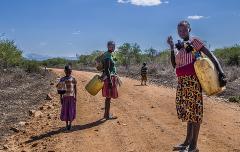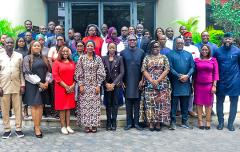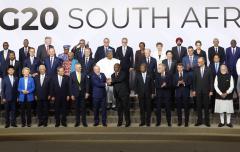Sustainable Energy for All (SEforALL) Hosts High-Level Finance Panel
NEW YORK, 26 November 2013 – At a high-level finance panel co-organized by the offices of the Permanent Mission of Germany to the United Nations and the Sustainable Energy for All on the margins of the Advisory Board meeting, panelists affirmed that the initiative’s three inter-linked global objectives of universal access to modern energy services, double the rate of improvement in energy efficiency, and double the share of renewable energy in the global energy mix by 2030 are ambitious but achievable.
Moderated by Michael Liebreich, CEO, Bloomberg New Energy Finance, the panel tackled the challenges thwarting the flow of funds to the energy sector noting specifically that meeting the SEforALL objectives would require an estimated doubling or tripling of recent capital flows of about $400 billion a year to the energy sector and a parallel effort is needed to mobilize private capital for the multi-billion dollar pipeline of energy investments that will result.
Eighty SEforALL partner countries are currently receiving technical assistance to develop energy investment plans. However, an energy revolution is only possible when policy issues and structural constraints currently impeding a larger flow of funds to the energy sector are addressed.
The challenges include improving the policy environment for private investments in energy, increasing the financial and human resources dedicated to project preparation, bringing mainstream investors into emerging energy markets, harnessing the strength of commercial banks, increasing the leverage of attractive but limited development resources and aggregating small-scale projects to meet minimum financing thresholds.
1) Improving the policy environment for private investments in energy.
The viability of long term energy investments is critically dependent on energy pricing policies and the existence of a stable regulatory environment. Any measures to improve the availability of finance for emerging market energy projects will only ultimately be successful if countries are able to create a sound policy environment to support private sector investments. While political risk mitigation instruments have a valuable role to play, there is a limit to how far and for how long fundamental policy deficiencies can be offset in this way.
2) Increasing the financial and human resources dedicated to project preparation.
Project financiers often highlight a shortage of thoroughly prepared and bankable investment projects, as one of the key bottlenecks that prevents flow of funds to the sector. The preparation of larger scale energy projects is an expensive and time consuming process, often absorbing 5-10% of investment costs. At present, there is a shortage of funds and knowhow to undertake this critical preparation work. Funding project preparation is unattractive both to private investors and policy makers, due to uncertain cost recovery and long lead times before tangible results materialize.
3) Bringing mainstream investors into emerging energy markets.
The appetite of mainstream investors to finance energy projects is limited even in mature markets, let alone emerging ones. The new regulatory regime (Basel II and III) is making it difficult and far more expensive for commercial banks to provide long-term financing in emerging markets. As a result, such financing has dropped to minimal levels and if available can only be tapped with significant political and commercial risk mitigation and at exorbitant prices. Furthermore, institutional investors and Sovereign Wealth Funds, which manage huge capital resources with longer maturity profiles, have not shown any significant interest in the emerging markets energy sector, which is perceived as high risk and low return. A bridging device is needed to make emerging market energy projects more attractive to mainstream investors who hold much of the available capital. Both commercial banks and development banks potentially have a role to play.
4) Harnessing the strength of commercial banks.
There are several ways in which commercial banks could contribute to building this bridge. First, commercial banks offer valuable advisory and risk assessment skills as well as fixed-income banking services that could facilitate the capital flow from deep-pocketed institutional investors and Sovereign Wealth Funds to client countries. Second, by combining their expertise in bond markets and infrastructure project finance, commercial banks could spearhead the development of new instruments and approaches for capital market financing of emerging market energy projects. Third, commercial banks could take the short term construction risks on infrastructure projects (which they are best placed to assess) and once projects are in operational phase, commercial loans could be re-financed by institutional investors interested in longer maturity investments.
5) Increasing leverage of attractive but limited development bank resources.
As of today, development banks remain one of the main sources of concessional and/or long term finance available for funding energy infrastructure in emerging markets. Though limited in the capital they can raise, development banks can deal with some of the most challenging aspects of infrastructure finance through: project origination and due diligence; provision of political risk mitigation instruments, such as guarantees; and mitigation of credit (payment) risk. Development banks could greatly increase the impact of their limited resources by focusing more on their role as conveners of other sources of finance so as to further leverage their capital. Development banks could also go further in optimizing the use of their existing capital by matching the asset lives of particular investment to the maturity of the financing provided. Going forward, a new paradigm is needed whereby the development banks focus on bridging the gap between emerging market energy projects and mainstream sources of finance.
6) Aggregating small-scale projects to meet minimum financing thresholds.
Meeting the three SEforALL objectives will also require a massive expansion of small scale investments both in off-grid and mini-grid systems critical to rural service delivery. Despite successful pilots for private investment in these kinds of systems, there has been limited ability to expand these to a scale where they can have a material impact on the achievement of global energy goals. A key impediment to increasing finance is that the small size of these projects – at around US$2 million – makes them unattractive to impact investors whose threshold lies around the US$15 million mark. There is a need to develop aggregation mechanisms that can support the development of a large pool of enterprises with smaller scale projects that meet basic business plan and enterprise quality standards and can be certified for investment by larger investors.
Panelists include Carlos Pascual, Special Envoy and Coordinator for International Energy Affairs (US State Department), Michael Eckhart, Managing Director and Global Head of Environmental Finance (Citigroup), Kyung-Ah Park, Managing Director and Head of Power and Renewable Energy Banking (Goldman Sachs), Reema Nanavaty, Secretary-General, Self-Employed Women’s Association (India) and Rachel Kyte, vice president for Sustainable Development (The World Bank).



